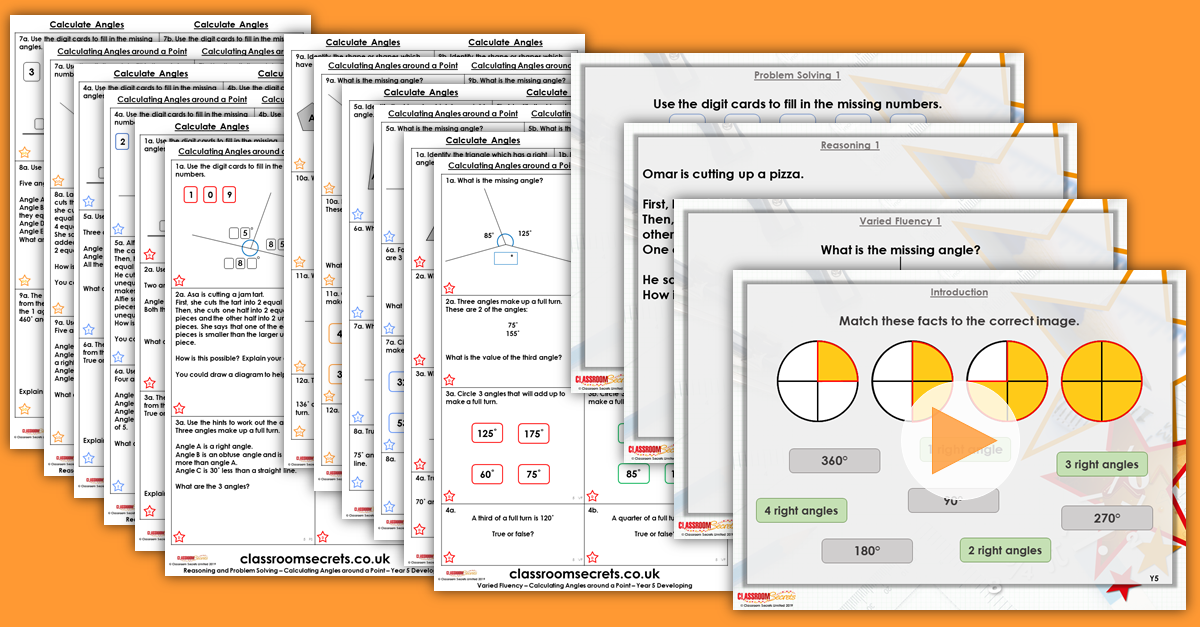Mixed Age Year 5 and 6 Properties of Shape 6 Resource Pack

Step 6: Mixed Age Year 5 and 6 Properties of Shape Step 6 Resource Pack
Mixed Age Year 5 and 6 Properties of Shape Step 6 Resource Pack includes a teaching PowerPoint and differentiated varied fluency and reasoning and problem solving resources for this step which covers Year 5 Calculating Angles Around a Point and Year 6 Calculating Angles for Summer Block 3.
Not a member? Sign up here.
What's included in the Pack?
This Mixed Age Year 5 and 6 Properties of Shape Step 6 pack includes:
- Mixed Age Year 5 and 6 Properties of Shape Step 6 Teaching PowerPoint with examples.
- Year 5 Calculating Angles Around a Point Varied Fluency with answers.
- Year 5 Calculating Angles Around a Point Reasoning and Problem Solving with answers.
- Year 6 Calculating Angles Varied Fluency with answers.
- Year 6 Calculating Angles Reasoning and Problem Solving with answers.
National Curriculum Objectives
Mathematics Year 5: (5G4b) Identify angles at a point and one whole turn (total 360)
Mathematics Year 6: (6G4b) Recognise angles where they meet at a point, are on a straight line, or are vertically opposite, and find missing angles
Differentiation for Year 5 Calculating Angles Around a Point:
Varied Fluency
Developing Questions to support calculating a missing angle around a point. Using 3 angles and increments of 5˚.
Expected Questions to support calculating a missing angle around a point. Using up to 5 angles and increments of 1˚.
Greater Depth Questions to support calculating 2 missing angles around a point. Using up to 5 angles and increments of 1˚. Some angles are labelled with degrees and clues given to calculate missing angles.
Reasoning and Problem Solving
Questions 1, 4 and 7 (Problem Solving)
Developing Use the digit cards to fill in the missing angles around a point. 3 missing numbers and 3 digit cards. Using 3 angles and increments of 5˚.
Expected Use the digit cards to fill in the missing angles around a point. 4 missing numbers and 5 digit cards. Using up to 5 angles and increments of 1˚.
Greater Depth Use the digit cards to fill in the missing angles around a point. 5 missing numbers and 6 digit cards. Using up to 5 angles and increments of 1˚.
Questions 2, 5 and 8 (Reasoning)
Developing Read the word problem and explain if the statement is correct. 2 or 3 steps. Using increments of 5˚.
Expected Read the word problem and explain if the statement is correct. 3 or 4 steps. Using increments of 1˚.
Greater Depth Read the word problem and explain if the statement is correct. More than 5 steps. Using increments of 1˚.
Questions 3, 6 and 9 (Problem Solving)
Developing Use the hints to work out what the 3 angles around a point are. Using increments of 5˚.
Expected Use the hints to work out what the 4 angles around a point are. Using increments of 1˚.
Greater Depth Use the hints to work out what the 5 angles around a point are. Using increments of 1˚.
Differentiation for Year 6 Calculating Angles:
Varied Fluency
Developing Questions to support calculating right angles and angles on a straight line; one missing angle to calculate. Angles given in multiples of 10.
Expected Questions to support calculating right angles, angles on a straight line and angles around a point; up to two missing angles to calculate. Angles given in multiples of 5.
Greater Depth Questions to support calculating right angles, angles on a straight line and angles around a point; two or more missing angles to calculate. Angles given in one degree increments.
Reasoning and Problem Solving
Questions 1, 4 and 7 (Problem Solving)
Developing Use the digit cards to work out the 3 missing 2-digit angles. 3 missing numbers. Angles given in multiples of 10.
Expected Use the digit cards to work the 3 missing 2-digit angles. 3 to 4 missing numbers. Angles given in multiples of 5.
Greater Depth Use the digit cards to work out the 3 missing 2-digit angles. 6 missing numbers. Angles given in one degree increments.
Questions 2, 5 and 8 (Problem Solving)
Developing Use the hints to work out the 2 or 3 angles which make up a right angle. Angles given in multiples of 10.
Expected Use the hints to work out the 3 or 4 angles which make up a 180˚ or 360˚ angle. Angles given in multiples of 5.
Greater Depth Use the hints to work out the 5 angles which make up a 360˚ angle. Using quarters, three-quarter and one-tenths of the full turn. Angles given in one degree increments.
Questions 3, 6 and 9 (Reasoning)
Developing Determine whether a statement relating to the distance a minute hand on a clock face moves to an angle is true or false. All movements equivalent to 90˚ or 180˚.
Expected Determine whether a statement relating to the distance a minute hand on a clock face moves to an angle is true or false. All movements in intervals of 10˚ to 360˚.
Greater Depth Determine whether a statement relating to the distance a minute hand on a clock face moves to an angle is true or false. All movements in interval of 10˚ past 360˚.
This resource is available to download with a Premium subscription.






